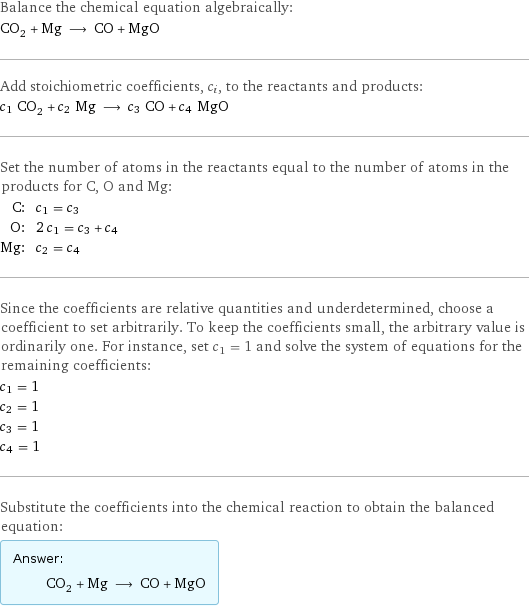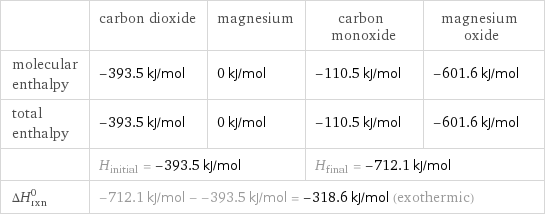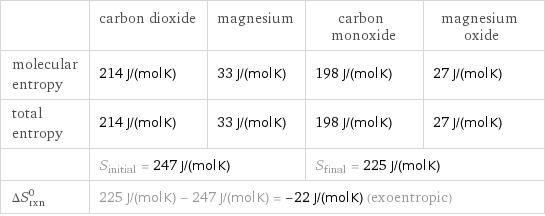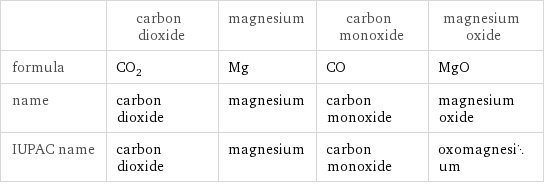Input interpretation

CO_2 carbon dioxide + Mg magnesium ⟶ CO carbon monoxide + MgO magnesium oxide
Balanced equation

Balance the chemical equation algebraically: CO_2 + Mg ⟶ CO + MgO Add stoichiometric coefficients, c_i, to the reactants and products: c_1 CO_2 + c_2 Mg ⟶ c_3 CO + c_4 MgO Set the number of atoms in the reactants equal to the number of atoms in the products for C, O and Mg: C: | c_1 = c_3 O: | 2 c_1 = c_3 + c_4 Mg: | c_2 = c_4 Since the coefficients are relative quantities and underdetermined, choose a coefficient to set arbitrarily. To keep the coefficients small, the arbitrary value is ordinarily one. For instance, set c_1 = 1 and solve the system of equations for the remaining coefficients: c_1 = 1 c_2 = 1 c_3 = 1 c_4 = 1 Substitute the coefficients into the chemical reaction to obtain the balanced equation: Answer: | | CO_2 + Mg ⟶ CO + MgO
Structures

+ ⟶ +
Names

carbon dioxide + magnesium ⟶ carbon monoxide + magnesium oxide
Reaction thermodynamics
Enthalpy

| carbon dioxide | magnesium | carbon monoxide | magnesium oxide molecular enthalpy | -393.5 kJ/mol | 0 kJ/mol | -110.5 kJ/mol | -601.6 kJ/mol total enthalpy | -393.5 kJ/mol | 0 kJ/mol | -110.5 kJ/mol | -601.6 kJ/mol | H_initial = -393.5 kJ/mol | | H_final = -712.1 kJ/mol | ΔH_rxn^0 | -712.1 kJ/mol - -393.5 kJ/mol = -318.6 kJ/mol (exothermic) | | |
Entropy

| carbon dioxide | magnesium | carbon monoxide | magnesium oxide molecular entropy | 214 J/(mol K) | 33 J/(mol K) | 198 J/(mol K) | 27 J/(mol K) total entropy | 214 J/(mol K) | 33 J/(mol K) | 198 J/(mol K) | 27 J/(mol K) | S_initial = 247 J/(mol K) | | S_final = 225 J/(mol K) | ΔS_rxn^0 | 225 J/(mol K) - 247 J/(mol K) = -22 J/(mol K) (exoentropic) | | |
Equilibrium constant
![Construct the equilibrium constant, K, expression for: CO_2 + Mg ⟶ CO + MgO Plan: • Balance the chemical equation. • Determine the stoichiometric numbers. • Assemble the activity expression for each chemical species. • Use the activity expressions to build the equilibrium constant expression. Write the balanced chemical equation: CO_2 + Mg ⟶ CO + MgO Assign stoichiometric numbers, ν_i, using the stoichiometric coefficients, c_i, from the balanced chemical equation in the following manner: ν_i = -c_i for reactants and ν_i = c_i for products: chemical species | c_i | ν_i CO_2 | 1 | -1 Mg | 1 | -1 CO | 1 | 1 MgO | 1 | 1 Assemble the activity expressions accounting for the state of matter and ν_i: chemical species | c_i | ν_i | activity expression CO_2 | 1 | -1 | ([CO2])^(-1) Mg | 1 | -1 | ([Mg])^(-1) CO | 1 | 1 | [CO] MgO | 1 | 1 | [MgO] The equilibrium constant symbol in the concentration basis is: K_c Mulitply the activity expressions to arrive at the K_c expression: Answer: | | K_c = ([CO2])^(-1) ([Mg])^(-1) [CO] [MgO] = ([CO] [MgO])/([CO2] [Mg])](../image_source/9daa7119a50d2123d37786b055297665.png)
Construct the equilibrium constant, K, expression for: CO_2 + Mg ⟶ CO + MgO Plan: • Balance the chemical equation. • Determine the stoichiometric numbers. • Assemble the activity expression for each chemical species. • Use the activity expressions to build the equilibrium constant expression. Write the balanced chemical equation: CO_2 + Mg ⟶ CO + MgO Assign stoichiometric numbers, ν_i, using the stoichiometric coefficients, c_i, from the balanced chemical equation in the following manner: ν_i = -c_i for reactants and ν_i = c_i for products: chemical species | c_i | ν_i CO_2 | 1 | -1 Mg | 1 | -1 CO | 1 | 1 MgO | 1 | 1 Assemble the activity expressions accounting for the state of matter and ν_i: chemical species | c_i | ν_i | activity expression CO_2 | 1 | -1 | ([CO2])^(-1) Mg | 1 | -1 | ([Mg])^(-1) CO | 1 | 1 | [CO] MgO | 1 | 1 | [MgO] The equilibrium constant symbol in the concentration basis is: K_c Mulitply the activity expressions to arrive at the K_c expression: Answer: | | K_c = ([CO2])^(-1) ([Mg])^(-1) [CO] [MgO] = ([CO] [MgO])/([CO2] [Mg])
Rate of reaction
![Construct the rate of reaction expression for: CO_2 + Mg ⟶ CO + MgO Plan: • Balance the chemical equation. • Determine the stoichiometric numbers. • Assemble the rate term for each chemical species. • Write the rate of reaction expression. Write the balanced chemical equation: CO_2 + Mg ⟶ CO + MgO Assign stoichiometric numbers, ν_i, using the stoichiometric coefficients, c_i, from the balanced chemical equation in the following manner: ν_i = -c_i for reactants and ν_i = c_i for products: chemical species | c_i | ν_i CO_2 | 1 | -1 Mg | 1 | -1 CO | 1 | 1 MgO | 1 | 1 The rate term for each chemical species, B_i, is 1/ν_i(Δ[B_i])/(Δt) where [B_i] is the amount concentration and t is time: chemical species | c_i | ν_i | rate term CO_2 | 1 | -1 | -(Δ[CO2])/(Δt) Mg | 1 | -1 | -(Δ[Mg])/(Δt) CO | 1 | 1 | (Δ[CO])/(Δt) MgO | 1 | 1 | (Δ[MgO])/(Δt) (for infinitesimal rate of change, replace Δ with d) Set the rate terms equal to each other to arrive at the rate expression: Answer: | | rate = -(Δ[CO2])/(Δt) = -(Δ[Mg])/(Δt) = (Δ[CO])/(Δt) = (Δ[MgO])/(Δt) (assuming constant volume and no accumulation of intermediates or side products)](../image_source/e02a8e1a63ba2cd20307dec157f67cf0.png)
Construct the rate of reaction expression for: CO_2 + Mg ⟶ CO + MgO Plan: • Balance the chemical equation. • Determine the stoichiometric numbers. • Assemble the rate term for each chemical species. • Write the rate of reaction expression. Write the balanced chemical equation: CO_2 + Mg ⟶ CO + MgO Assign stoichiometric numbers, ν_i, using the stoichiometric coefficients, c_i, from the balanced chemical equation in the following manner: ν_i = -c_i for reactants and ν_i = c_i for products: chemical species | c_i | ν_i CO_2 | 1 | -1 Mg | 1 | -1 CO | 1 | 1 MgO | 1 | 1 The rate term for each chemical species, B_i, is 1/ν_i(Δ[B_i])/(Δt) where [B_i] is the amount concentration and t is time: chemical species | c_i | ν_i | rate term CO_2 | 1 | -1 | -(Δ[CO2])/(Δt) Mg | 1 | -1 | -(Δ[Mg])/(Δt) CO | 1 | 1 | (Δ[CO])/(Δt) MgO | 1 | 1 | (Δ[MgO])/(Δt) (for infinitesimal rate of change, replace Δ with d) Set the rate terms equal to each other to arrive at the rate expression: Answer: | | rate = -(Δ[CO2])/(Δt) = -(Δ[Mg])/(Δt) = (Δ[CO])/(Δt) = (Δ[MgO])/(Δt) (assuming constant volume and no accumulation of intermediates or side products)
Chemical names and formulas

| carbon dioxide | magnesium | carbon monoxide | magnesium oxide formula | CO_2 | Mg | CO | MgO name | carbon dioxide | magnesium | carbon monoxide | magnesium oxide IUPAC name | carbon dioxide | magnesium | carbon monoxide | oxomagnesium